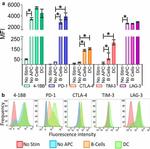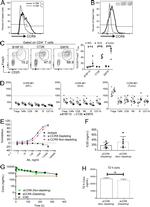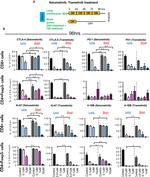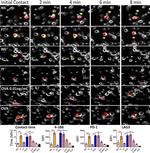Invitrogen
CD137 (4-1BB) Monoclonal Antibody (17B5), PE-Cyanine7, eBioscience™
FIGURE: 1 / 7
CD137 (4-1BB) Antibody (25-1371-82) in Flow







Product Details
25-1371-82
Species Reactivity
Published species
Host/Isotype
Recommended Isotype Control
Class
Type
Clone
Conjugate
Excitation/Emission Max
Form
Concentration
Purification
Storage buffer
Contains
Storage conditions
Shipping conditions
RRID
Product Specific Information
Description: The 17B5 monoclonal antibody reacts with mouse CD137, also known as 4-1BB, a member of the TNFR superfamily. CD137 is expressed as monomers, dimers, and tetramers on the surface of activated T cells around day 4-6 after activation through the TCR complex. Interaction of CD137 with its ligand, 4-1BBL, is reported to deliver a costimulatory signal important in the T-APC interaction. Recent data suggests CD317 is expressed on Tregs and may play a role in their proliferation. The monoclonal antibody 17B5 has strong antagonistic effect in in vitro functional assays.
Applications Reported: This 17B5 antibody has been reported for use in flow cytometric analysis.
Applications Tested: This 17B5 antibody has been tested by flow cytometric analysis of stimulated mouse splenocytes. This can be used at less than or equal to 1 µg per test. A test is defined as the amount (µg) of antibody that will stain a cell sample in a final volume of 100 µL. Cell number should be determined empirically but can range from 10^5 to 10^8 cells/test. It is recommended that the antibody be carefully titrated for optimal performance in the assay of interest.
Light sensitivity: This tandem dye is sensitive to photo-induced oxidation. Please protect this vial and stained samples from light.
Fixation: Samples can be stored in IC Fixation Buffer (Product # 00-822-49) (100 µL of cell sample + 100 µL of IC Fixation Buffer) or 1-step Fix/Lyse Solution (Product # 00-5333-54) for up to 3 days in the dark at 4°C with minimal impact on brightness and FRET efficiency/compensation. Some generalizations regarding fluorophore performance after fixation can be made, but clone specific performance should be determined empirically.
Excitation: 488-561 nm; Emission: 775 nm; Laser: Blue Laser, Green Laser, Yellow-Green Laser.
Filtration: 0.2 µm post-manufacturing filtered.
Target Information
CD137, also known as TNFRSF9 or 4-1BB, is an inducible costimulatory molecule expressed mainly on activated T cells. Its ligand, known as 4-1BBL, is expressed on activated macrophages, mature B cells, hematopoietic stem cells, and myeloid progenitor cells. CD137 signaling leads to maintaining the survival of activated T cells and CD8+ memory T cells, and clonal expansion of T cells, but also to suppressing myelopoiesis and dendritic cell development. Triggered CD137 induces a cytokine release profile regulating peripheral monocyte survival. Soluble forms of CD137 may provide negative control mechanism for some immune responses.
For Research Use Only. Not for use in diagnostic procedures. Not for resale without express authorization.
How to use the Panel Builder
Watch the video to learn how to use the Invitrogen Flow Cytometry Panel Builder to build your next flow cytometry panel in 5 easy steps.
Bioinformatics
Protein Aliases: 4 1 BB; 4-1BB ligand receptor; 41BB; CD137; CD137 antigen; s4 1 BB; s4 1BB; s41BB; sCD137; secreted CD137 antigen; soluble 4 1 BB; soluble 4 1BB; soluble 41BB; soluble CD137; T-cell antigen 4-1BB; Tumor necrosis factor receptor superfamily member 9
Gene Aliases: 4-1BB; A930040I11Rik; AA408498; AI325004; Cd137; CDw137; ILA; Ly63; Tnfrsf9
UniProt ID: (Mouse) P20334
Entrez Gene ID: (Mouse) 21942

Performance Guarantee
If an Invitrogen™ antibody doesn't perform as described on our website or datasheet,we'll replace the product at no cost to you, or provide you with a credit for a future purchase.*
Learn more
We're here to help
Get expert recommendations for common problems or connect directly with an on staff expert for technical assistance related to applications, equipment and general product use.
Contact tech support

